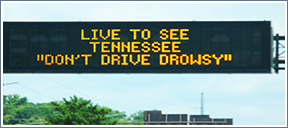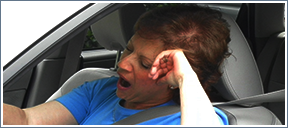Dangers of Drowsy Driving
“Live to See Tennessee – Don’t Drive Drowsy”
“Live to See Tennessee” is a statewide public safety campaign to raise awareness about the hazards of drowsy driving. The goals of this campaign are to educate the traveling public on the prevalence of drowsy driving and begin to lay the groundwork to prevent it.


The Centers for Disease Control and Prevention reported in 2013 that an estimated 15-33 percent of fatal crashes might involve drowsy drivers. Dr. Mark Rosekind, noted sleep scientist and now a member of the National Transportation Safety Board warns about the dangers of drowsy driving and the need for more public awareness. “For some reason people in our culture think it’s OK to lose sleep and get behind the wheel. It’s just as bad as drinking and driving. As far as public awareness, drowsy driving is in the dark ages,” he said.
Who’s at Risk?
- Young drivers, especially men under 26 years old
- New parents
- People working long shifts and/or more than 60 hours per week
- Shift workers, especially swing shift workers
- Long haul commercial drivers
- Business travelers that travel across time zones and suffer from “jet lag”
- People with undiagnosed or untreated sleep disorders like obstructive sleep apnea and narcolepsy – conditions that can cause excessive sleepiness
Drowsy Driving is a Choice
- A driver makes the choice to either drive drowsy or continue driving after becoming sleepy
- Driving drowsy can cause impairment equal to driving under the influence of alcohol
- A drowsy driver is usually unable to gauge the degree of his/her sleepiness
- When the need for sleep becomes overwhelming the driver does not have the ability to prevent it
- Choosing to drive drowsy is reckless behavior and a threat to public safety
The Signs of Drowsy Driving
- Fighting to stay awake
- Frequent yawning and eye blinking
- Head bobbing up and down – you have fallen asleep!
- Lane drifting/departures
- Hitting the rumble strip or shoulder of the road
Preventing a Drowsy Driving Accident
- Plan your trip in advance and make sure you get adequate sleep
- Do not start a trip tired or sleepy
- Check to see if any medications you are taking causes drowsiness
- Do not mix alcohol and sleepiness – never drink and drive
- Schedule regular stops (about every 100 miles or 2 hours)
- During stops participate in some brisk activity to promote alertness
- If drowsy – stop, drink some caffeine, and take a 15-20 minute power nap
- If drowsiness continues – find lodging and get a good night’s sleep!
* If you are frequently sleepy or fatigued consult your physician
A highway safety survey conducted by the Center for Transportation Research and the Center for Applied Research and Evaluation at the University of Tennessee found that ninety-four percent of drivers say driving drowsy is unacceptable, yet nearly a quarter of the respondents had admitted to driving drowsy in the last thirty days.
If you have any questions about drowsy driving, please contact the Tennessee Sleep Society at ltstddd@gmail.com.
Statistical information provided by the Tennessee Sleep Society.